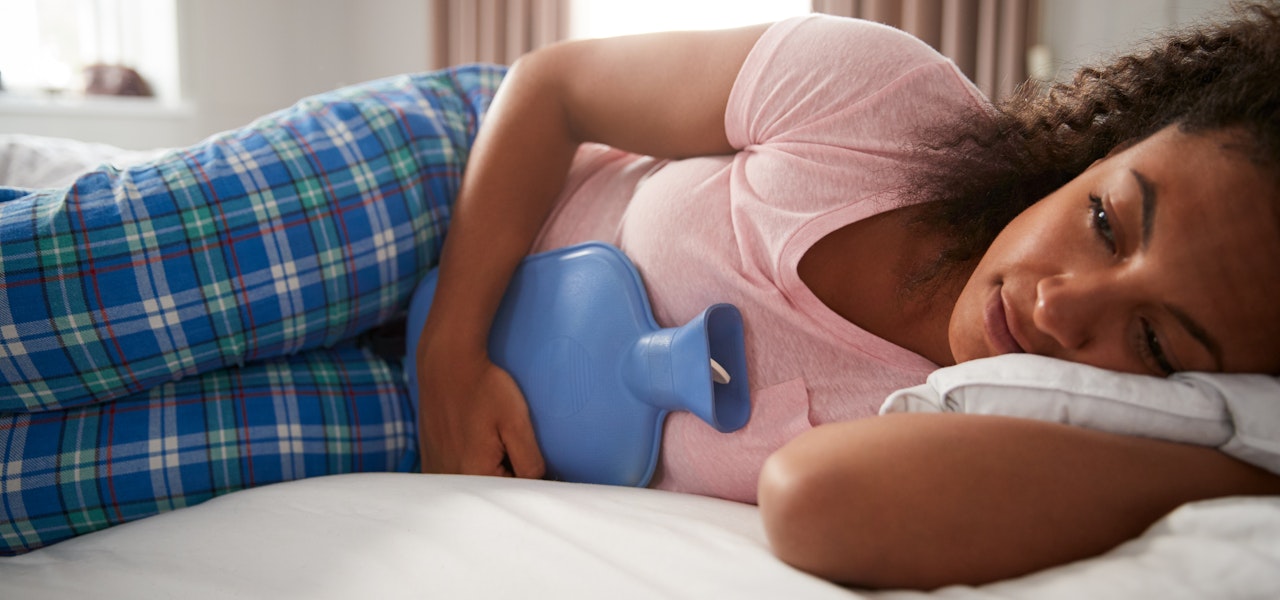Period pains, also known as menstrual cramps or dysmenorrhea, are a common symptom experienced by many women during their menstrual cycle. The pain typically occurs in the lower abdomen, though it can also affect the lower back, hips, or thighs. Period pain can vary in intensity, from mild discomfort to severe pain that interferes with daily activities. It is often divided into two types: primary dysmenorrhea and secondary dysmenorrhea.

1. Primary Dysmenorrhea
Primary dysmenorrhea refers to common menstrual cramps that are not caused by any underlying medical condition. This type of pain usually begins 1–2 days before or at the onset of menstruation and lasts 1–3 days.
Causes of Primary Dysmenorrhea:
- Prostaglandins: During menstruation, the uterus contracts to help shed its lining. These contractions are triggered by hormone-like substances called prostaglandins. Higher levels of prostaglandins are associated with more intense uterine contractions, leading to more severe period pain.
- Reduced blood flow: The strong contractions can temporarily reduce blood flow to the uterus, contributing to cramping and pain.
Symptoms of Primary Dysmenorrhea:
- Throbbing or cramping pain in the lower abdomen
- Pain that radiates to the lower back and thighs
- Nausea, vomiting, or diarrhea in some cases
- Headaches or dizziness
Risk Factors:
- Being younger (period pain often starts during adolescence)
- Heavy menstrual flow
- Family history of dysmenorrhea
- Smoking or being overweight
2. Secondary Dysmenorrhea
Secondary dysmenorrhea is caused by an underlying medical condition affecting the reproductive organs. This type of pain usually starts later in life, often after age 25, and can last longer than primary dysmenorrhea.
Causes of Secondary Dysmenorrhea:
- Endometriosis: A condition where tissue similar to the uterine lining grows outside the uterus, often causing severe menstrual pain and discomfort.
- Fibroids: Noncancerous growths in the uterus that can cause painful periods, heavy bleeding, and pelvic pressure.
- Adenomyosis: A condition where the uterine lining grows into the muscular wall of the uterus, leading to painful periods and heavy bleeding.
- Pelvic Inflammatory Disease (PID): An infection of the reproductive organs, often caused by untreated sexually transmitted infections (STIs), can lead to painful menstruation.
- Ovarian cysts: Fluid-filled sacs that can form on the ovaries may cause pain during menstruation, especially if they rupture.
- Intrauterine Device (IUD): Some women experience more painful periods after the insertion of a copper IUD, a form of birth control.
Symptoms of Secondary Dysmenorrhea:
- Menstrual pain that begins earlier in the menstrual cycle or lasts longer than usual
- Pain that worsens over time or during sexual intercourse
- Heavier periods or irregular bleeding
- Symptoms of the underlying condition (e.g., pelvic pain between periods, digestive issues)
Managing Period Pain
There are several ways to manage period pain, depending on the severity of symptoms and whether an underlying condition is present.
1. Over-the-Counter Pain Relief
- Nonsteroidal Anti-Inflammatory Drugs (NSAIDs): Medications like ibuprofen or naproxen reduce the production of prostaglandins, which helps ease menstrual cramps.
- Acetaminophen: While not as effective as NSAIDs in reducing prostaglandin production, acetaminophen can still provide some relief for mild pain.
2. Heat Therapy
- Applying a heating pad or hot water bottle to the lower abdomen can help relax the muscles of the uterus and improve blood flow, reducing cramping and pain.
3. Lifestyle Changes
- Exercise: Regular physical activity can help reduce the severity of menstrual cramps by increasing circulation and releasing endorphins, which act as natural painkillers.
- Dietary changes: Eating a healthy, balanced diet and avoiding excess salt, caffeine, and sugar can help reduce bloating and discomfort.
- Hydration: Drinking plenty of water can help reduce bloating and ease period pain.
4. Hormonal Birth Control
- Oral contraceptives, birth control patches, IUDs, or other forms of hormonal birth control can reduce period pain by thinning the uterine lining and lowering prostaglandin levels.
- These methods can also help regulate periods and make menstrual cycles lighter and less painful.
5. Relaxation Techniques
- Yoga, meditation, and deep breathing exercises can help relax the body, reduce stress, and alleviate menstrual cramps.
6. Dietary Supplements
- Certain vitamins and minerals, like vitamin B1, magnesium, and omega-3 fatty acids, have been shown to reduce menstrual pain in some studies. Always consult a healthcare provider before starting supplements.

When to See a Doctor
While mild to moderate period pain is common, certain symptoms may indicate an underlying condition requiring medical attention:
- Pain that is severe enough to interfere with daily activities
- Period pain that gets worse over time or starts suddenly in adulthood
- Heavy menstrual bleeding or passing large clots
- Irregular periods or bleeding between periods
- Pain during sexual intercourse
- Symptoms of infection, such as fever or unusual vaginal discharge
A healthcare provider can perform a physical examination, ultrasound, or other diagnostic tests to determine the cause of severe period pain and recommend appropriate treatment. For secondary dysmenorrhea, treating the underlying condition (e.g., endometriosis, fibroids) may be necessary to alleviate the pain.
Related:
Common early signs of pregnancy



0 Comments